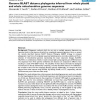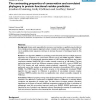146 search results - page 26 / 30 » Segment-Based Scores for Pairwise and Multiple Sequence Alig... |
BMCBI
2006
13 years 7 months ago
2006
Background: Phylogenetic methods which do not rely on multiple sequence alignments are important tools in inferring trees directly from completely sequenced genomes. Here, we exte...
BMCBI
2008
13 years 7 months ago
2008
Background: Amino acids responsible for structure, core function or specificity may be inferred from multiple protein sequence alignments where a limited set of residue types are ...
BMCBI
2010
13 years 7 months ago
2010
Background: The incorporation of annotated sequence information from multiple related species in commonly used databases (Ensembl, Flybase, Saccharomyces Genome Database, Wormbase...
FPL
2010
Springer
13 years 5 months ago
2010
Springer
We demonstrate how Field Programmable Gate Arrays (FPGAs) may be used to address the computing challenges associated with assembling genome sequences from recent ultra-high-through...
BMCBI
2007
13 years 7 months ago
2007
Background: Over the past decade, a number of tools have emerged for the examination of homology relationships among protein sequences in a structural context. Most recent softwar...


